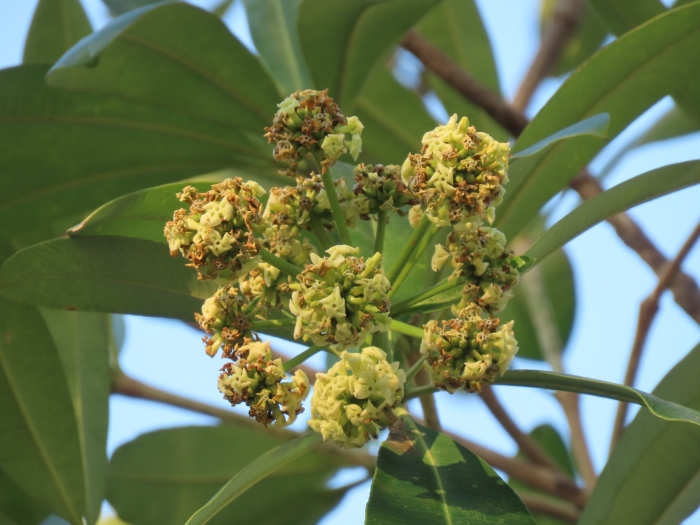Blackboard Tree
(Alstonia scholaris)
Blackboard Tree (Alstonia scholaris)
/
/

© chiuluan
CC BY 4.0
Image By:
© chiuluan
Recorded By:
Copyright:
CC BY 4.0
Copyright Notice:
Photo by: © chiuluan | License Type: CC BY 4.0 | License URL: http://creativecommons.org/licenses/by/4.0/ | Uploader: chiuluan | Publisher: iNaturalist |
























Estimated Native Range
Summary
Alstonia scholaris, commonly known as Blackboard Tree or Devil’s Tree, is an evergreen tropical tree native to rainforests and monsoon forests in Southern China, tropical Asia, and Australasia. It can grow up to 131 feet (40 meters) tall with a straight trunk and a grayish, sometimes cracked bark. The glossy, dark green leaves are arranged in whorls of 3 to 10 and can be up to 8 inches (20 cm) long. From September to November, it produces clusters of small, tubular, white flowers that are highly fragrant, especially at night. The flowers are followed by long, slender seed pods.
The Blackboard Tree is valued for its medicinal properties, as various parts of the plant are used in traditional medicine. It is also planted as an ornamental due to its striking foliage and fragrant flowers. In cultivation, it requires a tropical or subtropical climate, with high humidity and well-drained soil. It prefers full sun to partial shade and regular watering, especially during dry periods. While it is not commonly grown in temperate regions, it can be cultivated in greenhouses where conditions mimic its native habitat. Gardeners should be aware that Alstonia scholaris has a milky sap that can be irritating to the skin and toxic if ingested. Additionally, it is potentially invasive in some regions, so it is important to check local regulations before planting.CC BY-SA 4.0
The Blackboard Tree is valued for its medicinal properties, as various parts of the plant are used in traditional medicine. It is also planted as an ornamental due to its striking foliage and fragrant flowers. In cultivation, it requires a tropical or subtropical climate, with high humidity and well-drained soil. It prefers full sun to partial shade and regular watering, especially during dry periods. While it is not commonly grown in temperate regions, it can be cultivated in greenhouses where conditions mimic its native habitat. Gardeners should be aware that Alstonia scholaris has a milky sap that can be irritating to the skin and toxic if ingested. Additionally, it is potentially invasive in some regions, so it is important to check local regulations before planting.CC BY-SA 4.0
Plant Description
- Plant Type: Tree
- Height: 60-100 feet
- Width: 20-30 feet
- Growth Rate: Rapid
- Flower Color: White
- Flowering Season: Fall
- Leaf Retention: Evergreen
Growth Requirements
- Sun: Full Sun
- Water: Medium
- Drainage: Medium, Fast
Common Uses
Showy Flowers, Street Planting
Natural Habitat
Native to rainforests and monsoon forests in Southern China, tropical Asia, and Australasia
Other Names
Common Names: Blackboard Tree, Devil’s Tree, Deviltree, Ditabark, Milkwood-Pine, Milky Pine, Dita Tree, Milky-Bean
Scientific Names: , Alstonia scholaris, Aeschynomene laevis, Alstonia kurzii, Alstonia scholaris subsp. avae, Alstonia scholaris subsp. blumii, Alstonia scholaris subsp. velutina, Alstonia scholaris var. avae, Alstonia scholaris var. avii, Alstonia scholaris var. blumei
GBIF Accepted Name: